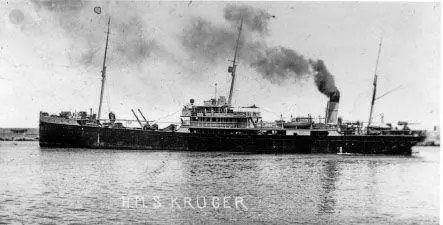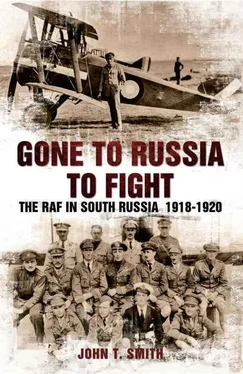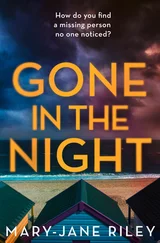The two Martinsydes, during the twenty-one days they were flying in Baku, carried out reconnaissances, bombing, and leaflet dropping. Rumours of German-flown fighter aircraft proved to be false and no aerial opposition was encountered. An attempt was made to carry out spotting for the Russian artillery gunners, but the Martinsydes were not equipped with radio. A system of dropping information in message bags was tried, but this did not work very well.
In the harbour at Baku was the Centro-Caspian Flotilla, comprising a number of armed ships. This naval force was nominally supporting the political leadership on the shore, but was in reality only maintaining its own position. The Flotilla was determined to stop the British from arming any more ships, as this would threaten their situation of superiority on the Caspian. After heavy fighting, the Turks closed in on the port and General Dunsterville told the Armenians that if they could not hold the Turks off the British would have to evacuate.
The RAF personnel were forced to evacuate on 4 September, along with the rest of the Army. Lieutenant Mackay wrote the report on the evacuation. It is worth quoting the report in full:
About an hour before daybreak on the 14th September, the Turks attacked the Allied lines West of Baku. Their main attack was concentrated on Wolf’s Gap – a large break in the British Ridge – through which ran a road. At dawn Lieutenant Mackay flew over this sector of the line and observed troops on the British ridge. Owing to cloud and mist at 1,000 ft. the identification of these troops was difficult, and to avoid any mistake the pilot flew farther West to the Turkish ridge where enemy reserves were seen halted on the Western slopes. Six drums from the Lewis were fired into these troops and a report taken back to HQ as to their whereabouts. During the morning Lieutenant Pope did two reconnaissances – the first of 30 minutes – the second of 55 minutes. During the first, three drums were fired on to troops on the British ridge, who had now been identified as Turks. Owing to the gas regulator key falling away from his gun, Lieutenant Pope returned to the aerodrome – but the trouble having been remedied – again took off and crossed the Turkish lines.
Six drums were fired into Turkish troops who were now about half way between the old British ridge and Baku. Lieutenant Mackay crossed the enemy lines shortly after this and again fired six drums into the enemy reserves and the British ridge. The last three flights were carried out at 1,500 ft. Lieutenant Pope’s machine had been unserviceable for a day or so previously and owing to shortage of mechanics and time required to be spent on the serviceable machine, only one machine flew on the 14th September. By 12.15pm on this day the machine was unfit to fly owing to hits from rifle and machine gun fire from the ground – and at 3pm orders were received from the G. O. C. British troops Baku, to destroy the two machines, their flying to Krasnovodsk, Lenkoran or Enzeli being out of the question. At 3.45pm the machines were burnt, the engine being rendered useless by revolver bullets and an axe. At 4.15pm Lieutenants Pope and Mackay left the aerodrome which was then under shell fire – taking away with them one (top) machine gun and three cameras. The RAF personnel was ordered to take one of the remaining machine guns and several drums of ammunition and join the British line which was then close to the northern end of the aerodrome. The third machine gun was smashed.
Bradley, with Lieutenants Pope and Mackay then left the aerodrome and proceeded to the Hotel Europa where all photographic chemicals and plates which were unable to be got away were destroyed. At 5pm Lieutenant Pope and Mackay were ordered to embark on a ship which got safely out of Baku at 8pm. The RAF personnel evacuated with the other British troops and were picked up at Enzeli. They had smashed up the last machine gun just before retiring to the quay at Baku. On the 18th instant a RAF tender arrived from Kasvan and took all RAF personnel back with it. [4]
The three British-commanded ships in the harbour at Baku were the Abo , the Kursk and the Kruger . During the afternoon of 14 August, the British forces began to pull back towards the harbour in an orderly fashion. The Centro-Caspian Flotilla in the harbour at Baku had stated that they would fire on any British ships that tried to leave. According to Navy records, the Abo left at 18.30 hours, carrying women, wounded, and various small parties (including the RAF officers). All the ships in the harbour were getting up steam and preparing to sail and nobody seems to have noticed the Abo leave. As the Army moved back to the port, the quay became choked with lorries, armoured cars, and mules, which all had to be abandoned. The Kursk left the harbour, carrying troops, around 23.00 hours. Some of the artillery was loaded onto the Kruger , and when it was clear that no one had been left behind, the ship pulled out of the harbour at 01.00 hours on 15 August. The Russian guard ship fired on the Kruger but no hits were achieved. All three ships arrived in Enzeli later the same day.

HMS Kruger , General Dunsterville’s flagship.
The Turks entered the town within hours of the British departure and in three days of massacre the Azerbaijanis killed 16,000 Armenians. After six weeks, the British were back in Enzeli where they had started. A number of ships had fled the fall of Baku and these were now in the harbour at Enzeli. The workshop facilities at Enzeli were limited, but work was started on the SS Ventuir with the intention of mounting on the vessel some of the guns that were now being delivered from Baghdad.
Commodore Norris decided to visit Krasnovodsk, on the eastern coast, to look for a better-equipped dockyard to use as a base. Krasnovodsk was controlled by an anti-Bolshevik committee and welcomed the British ship. There was a large railway workshop at Krasnovodsk and the British decided to use this as their fitting-out base. By the end of October, there were five armed British ships on the Caspian. These were the Kruger , Ventuir , Asia , Alla Verdi , and Emile Nobel . None of these were very large; they were all in poor condition and their guns were old-fashioned, but they did provide the basis of a British fleet on the Caspian.
In September, Commodore Norris had a serious accident and the command on the Caspian passed to Captain Washington. Also at this time, General Dunsterville was given a command in India and was replaced by General W. M. Thompson. Three more ships, the Bibiat , the Slava , and the Zoro-Aster , were in the process of being armed, thought ammunition remained in short supply. Eight 4.7-inch shells was one camel load for the 700-mile trip across north Persia from Baghdad. On 31 October, the Turks signed an armistice with the Allies.
The British naval squadron now began a series of cruises on the Caspian. Early in November, the five armed ships visited Petrovsk, north of Baku, and the Asia was sent to Guryev, a port on the river Ural. This was the headquarters of the Ural Cossacks, who were part of the White Russian forces fighting against the Reds. The main Bolshevik base on the Caspian was the port of Astrakhan, on the mouth of the Volga River. Using canals, it was possible to bring armed ships from the Baltic onto the Volga and down to the Caspian at Astrakhan. Using this supply route, the Bolsheviks were building up their forces in the north of the Caspian.
Читать дальше













